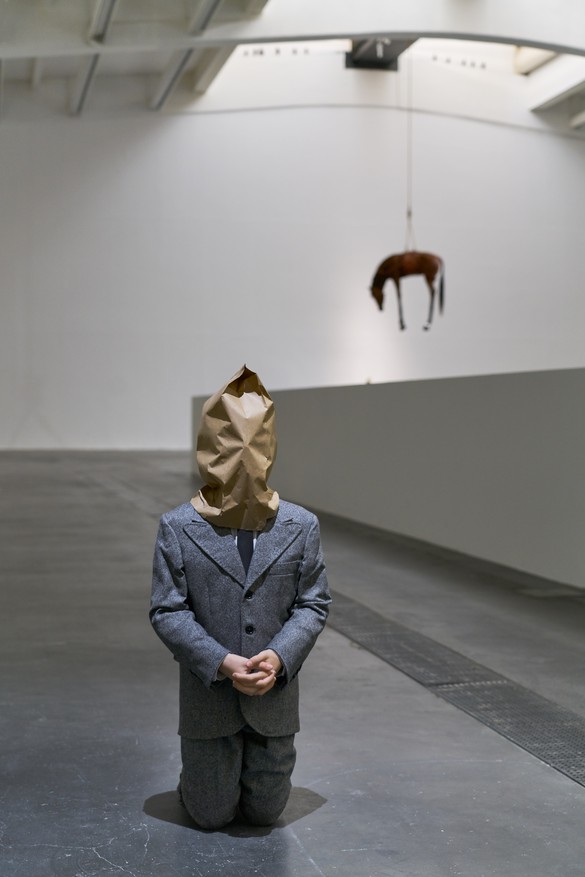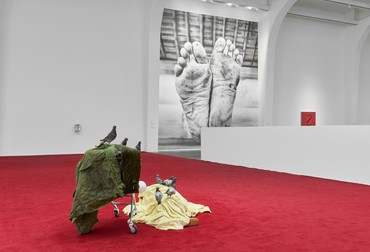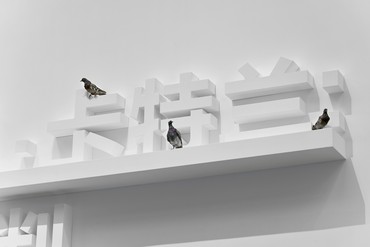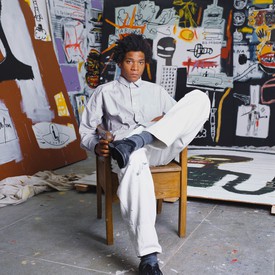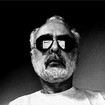
Francesco Bonami has curated more than one hundred exhibitions, among them the Venice Biennale in 2003 and the Whitney Biennial in 2010. He writes for La Repubblica, Artnews, and Vogue Italia. His most recent books include Post: L’opera d’arte nell’epoca della sua riproducibilità sociale (Feltrinelli, 2019) and Mum, I Want to Be an Artist: How to Avoid Delusions (Karma Books, forthcoming).
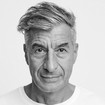
Maurizio Cattelan is a failed accountant who kills time doing art.
While organizing the first major retrospective of Maurizio Cattelan’s work in China, at the UCCA Center for Contemporary Art in Beijing, I had the opportunity to convince my friend to agree to this interview. We met first at the Torre di Pisa restaurant in Milan, then at a Chinese restaurant near his apartment in New York. Despite his early retirement after his exhibition at New York’s Solomon R. Guggenheim Museum in 2011–12, Cattelan has never lost his taste for a good provocation, crashing back into the art world, for example, with his prescient golden toilet, America, at the Guggenheim in 2016. He is deeply entertaining yet equally deeply capable of transforming the rules of the game. One of his better skills has always been to avoid roadblocks, whether in his own imagination or arising through the cowardice of institutions. In China, to spare the host institution questions from officialdom while keeping two seminal works in the show, he transformed the famous pope in La Nona Ora (The ninth hour, 1999) into a homeless person covered with pigeons, suggesting a likely destiny for the head of the Catholic Church after its tsunami of sexual scandals. HIM (2001), the kneeling and praying Hitler, already presented at Gagosian in London in 2014 in front of a pink Fine di Dio (The end of God) by Lucio Fontana, was presented in Beijing with a paper bag over his head. I asked if this was a reference to Abu Ghraib prison in Iraq.
—Francesco Bonami
MAURIZIO CATTELANWhy? You have to see something violent in a simple paper bag? I was always fascinated by the hypocritical law in the United States that forced people drinking beer in public to hide the bottle in a brown paper bag. Most of the time you just had to look at the person’s face to figure out he or she wasn’t drinking a soda. So I thought I could hide the face of Hitler by just placing a paper bag on it. But then I was walking in Milan and I saw a bunch of tourists standing in front of a church wearing these very clumsy VR glasses and I thought, Wouldn’t it be great if technology could create a simple paper bag that you put over your head and inside you could experience a totally different universe? Outside you see the lowest-tech device and inside you’re projected into a totally different dimension. I like the contrast between the paper bag and an augmented reality of the utmost sophistication. Plus it came in handy to present the work in a complicated context like Beijing.
FRANCESCO BONAMII didn’t want to open a can of worms.
MCI’ve never used worms but that could be an idea . . .
FBYou used pigeons, which are a kind of worm with wings and feathers. Why did you call the work Tourists, Ghosts, Kids?
MCWhen I was a kid I used to see all these pigeons in my city’s squares with people selling corn to tourists who wanted a picture taken with a pigeon eating from their hands. But one day my mother brought me to the movie theater to see Hitchcock’s The Birds [1963]. It freaked me out. For years, I couldn’t go near a square invaded by those birds. Luckily they became pests and they were . . . let’s say . . . relocated.
The titles refer usually to groups of individuals seen as a whole. The tourists in particular—in Italy we see them not as a group of people each with his or her own identity but as a bunch of humans who all look the same and who are threatening our environment and peaceful daily life. Kids are a little bit the same. They move in a group; they’re noisy and in some ways also a menace. Kids together can produce quite a bit of damage. They’re a liability. Ghosts, I don’t know but I feel they’re the same: they move in groups, they gather together to divide houses to haunt among themselves. You think of pigeons as a mass, not as individual animals . . . forget about pets.
FBWhy so many? Why everywhere?
MCI use them as decoration the way someone would use a motif of flowers on top of a room. But my decoration is disturbing. Actually, I think all decoration is disturbing. I agree with the architect Adolf Loos on this. Pigeons give any space or architecture an eerie feeling—the viewer feels watched, controlled in some way by an unknown entity. When people are uncomfortable, they’re more aware of what they’re looking at. I guess pigeons help my work to avoid being dismissed right away.
FBAre you afraid of being dismissed?
MCVery much so! It’s my life’s worst fear. It took me a long time to climb up to where I am and I’m still terrified of being kicked out. I have an intruder complex: sooner or later I fear they’ll find out I wasn’t invited and they’ll throw me out of the art world.
FBOnce I said you were an impostor and you got kind of upset.
MCYes, I was upset because an impostor is someone who wants to be someone else, who presents himself as someone he is not. You can say whatever you want about me but you can’t say I tried or try to be someone else. I am who I’ve always been. I have many flaws, okay, but my flaws are not someone else’s.
FBDo you work on your flaws?
MCDo you work on yours? I mean, what kind of a question is that! No, I don’t work on my flaws because I built my identity on them and if I’ve ever been able to make a good work of art, it was because of my flaws and the flaws of the people I grew up with. You work on your flaws if they stop you from being what you want to be, or from being successful in what you do.
FBWith America you ended up on the front page of the New York Post. If you had to choose between selling the work and being on the front page of the Post, what would you have chosen?
MCThe front page for two reasons. First, a work’s goal and duty are to reach as many people as possible. Any artist who denies this is a liar. Second, because it’s like that famous saying from Naples: “Having power is better than fucking.” That’s simply because if you fuck too much, fuck most of the time, you can’t concentrate on getting power, but if you have power, you can usually find time to fuck as much as you like. That’s the big problem with powerful people. So if I’d chosen to sell the work and not have the front page of the New York Post, I would have given up the work’s purpose. But having the front page I’m sure helped sell the work.
FBAmerica was supposed to be a public work, used by as many people as needed to use it. Now it’s in a private collection, used, maybe, by a few people, though maybe it’s presented on a pedestal. How do you feel about that?
MCNo good. The meaning of the work is definitely diminished. Its true meaning was activated at its maximum when common people had the opportunity to use something very elitist. Sure, part of the meaning is due to the encounter between a precious material like gold and poor discarded elements from our body. I want to hope that the owner of the work frees himself in it to give it its meaning as an artwork. I don’t know if it’s true, but I’ve heard this story of [Marcel] Duchamp being pestered by some relative to give him a work. Finally Duchamp agreed and gave the guy a book to hang outside the window. The work was the book hanging from the window. If the owner pulled the book in to show it, it wasn’t a work of art any longer. Well, I think a little bit the same about America: if you don’t use it, it goes back to being just an expensive toilet, not a work of art.
My work is about wondering who we’re around for. My work is about getting the attention of the grown-up. I guarantee you it’s still a struggle.
—Maurizio Cattelan
FBYou’ve told me that you didn’t sell a work for almost six, seven years. Is that true?
MCYes, it is.
FBYou didn’t want to sell work?
MCNo, people just weren’t interested in my work for a while.
FBWhy?
MCI’d announced my retirement. Can you blame them? It was like buying a car from a company that had announced it was closing. With artists it’s even more problematic because if they’re alive and stop working, that could do a lot of damage to the existing work. When you stop being an artist you become very bitter and you maybe want to take revenge with your existing work.
FBWhy did you decide to come back?
MCI didn’t want to be bitter.
FBAnd you started selling again.
MCNot right away, it took me a while. America helped me to get back on track without selling out.
FBWhy that work?
MCIt belonged to the luxury world but at the same time it was accessible, popular, understandable, not really even for sale. It stirred desire in the head of the elite but maintained its place in people’s imagination.
FBThen Comedian [2019] came and eclipsed everything you’d done before.
MCI think that’s an exaggeration. It definitely took me by surprise, it started to have a life of its own I wasn’t expecting, but I don’t think it erased everything . . . I hope not.
FBWhere did it pop out, this banana idea?
MCYou must know one of my biggest frustrations is not being able to paint. I tried many times in different ways but I’m the negation of a painter. I can’t, that’s it. I have to live with it. I was in New York, it was the fall of 2019, and I was going through galleries and looking at auction results. Painting, painting, painting. Most of them sold for absurd prices.
FBYou were envious of the prices.
MCYes, of course I was. But I also thought about the idea of painting and what a painting is. A painting is the most recognizable symbolic space in the history of art. Anybody, really anybody, can take a rectangular or square piece of wood, canvas, or paper, put something over it—color, shit, straw—hang it on the wall, and whoever sees it will call that thing a painting. Never mind good or bad. So I thought about something that, without being a painting, could compete with a painting. Something that anybody could see and know what it is. I guess everybody knows what a banana is.
FBBut now, those who see that banana attached to the wall with gray gaffer’s tape will think about you.
MCI don’t know what they think; I just know that Comedian has a life by itself.
FBWhy “comedian”?
MCA comedian is not an actor but is not a normal person either. A comedian lives in the limbo between fiction and reality. A comedian is someone who can fail very easily. A comedian is doomed to make people laugh—an actor has the option of making people cry. Comedian is not a painting, it’s between conceptual art and a joke. Conceptual art doesn’t have any emotion; a joke usually doesn’t carry any big thought.
FBSo why is it so successful?
MCLike a joke makes you happy, makes you smile, it’s comfort art, if you want to call it art. Not much art makes you truly happy and comfortable. But it has another quality: it’s not a gadget. It’s not art turned into a gadget. It is what it is.
FBPeople compared it with Duchamp’s Fountain [1917].
MCI know I risk sounding slightly arrogant but Comedian is more honest than Fountain. Duchamp took an object and presented it as an abstract sculpture, deceiving the viewer with its presentation and with its signature. Comedian takes the existing context—two existing elements, the tape and the banana—and places them as they are on a white wall. The fact that it was presented at an art fair changed the perception a little but not much. It works perfectly well on a huge wall in the show in Beijing. As people used to say, “It holds the space very well.”
FBThe last time you chose to show in a private gallery was in 2002, at Marian Goodman in New York, where you presented Frank and Jamie, two policemen leaning against the wall upside down. There’s a reason why you chose not to do shows in galleries for so long.
MCIt’s a little like with sentimental relationships. Until you break the habit of seeing each other you never end any relationship. In this case I didn’t end a relationship with any of my dealers but I ended the bad habit of being tempted by gallery shows. Like smoking—it doesn’t mean I won’t start smoking again, but it’s unlikely. I trapped myself in a sort of public sphere that I can’t escape any longer. I guess it was the same for Christo and Jeanne-Claude: once you wrap the Reichstag, you can’t go back to wrapping a chair for a gallery show.
FBThat’s why in your last show in Milan you went for a work—Blind [2021], a clear reference to 9/11—that I feel demands a public context.
MCYes, I tried to pitch Blind for a public space but nobody wanted to take the chance. 9/11 is still a loaded subject.
FBDid you want to push people’s buttons?
MCNot at all! I wanted to push the button of our collective memory. But I realize it’s too soon to reset it. Until now, with COVID, 9/11 was the only event the whole world shared and could not cope with. I deluded myself that Blind could be a kind of closure through art. People responded, Wow! Not, Ouch! Which I guess was what I went for.
FBCompared with other successful artists of your generation, you’ve kept a very modest lifestyle. Is it an attitude or your real way of living?
MCWhat do you mean “modest”? I live a very comfortable life. There’s no modesty in my lifestyle. It is what it is, which means it is what I need. If you want a more philosophical answer, I could say that I know how to fall but I’d rather fall from not too big of a height.
FBWhat is your work really about? People revere you. People praise you. People despise you. Do they really know what the work’s about?
MCMy guess is as good as theirs. My work is about wondering who we’re around for. My work is about getting the attention of the grown-up. I guarantee you it’s still a struggle, and it’s very painful to keep seeing in the eyes of many critics and curators that glance of mistrust about my work. I often still fight to be taken seriously. It took me years to shed the stigma of being a one-liner artist, or even to be considered an artist.
FBI still vividly remember when in Venice in 1993 I was walking with a very influential and powerful art consultant under Lavorare è un brutto mestiere [Working is a bad job, 1993], the huge billboard a perfume company put up in the space I gave you and that you leased to them. I was explaining the “meaning” of the “work” to her and she dismissed it: “Boring, nothing new, already done.” I still think about it. I met her a few years later and she told me you were a genius and she was trying to buy one of your works for a client.
MCIs she still around?
FBNot really.
MCWell, I guess it matches what you and I always remind each other: names in the art world are written in pencil.
FBAs a middle-aged white European male, are you concerned about ending up canceled in some way?
MCThat goes with the fear of disappearing or being kicked out. In my case it has nothing to do with culture, it has to do with social status or class struggle. But I wouldn’t be surprised if soon enough some kind of mob pulled down my L.O.V.E. monument in Milan. You never see hedge-fund guys taking to the street to protest. If, for once, they had the guts to do it, I think they’d be the ones to throw that sculpture down.
Artwork © Maurizio Cattelan; photos: Sun Shi, courtesy UCCA Center for Contemporary Art, Beijing
